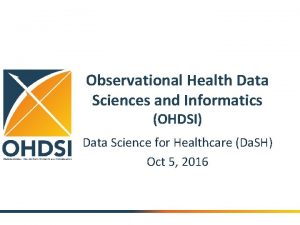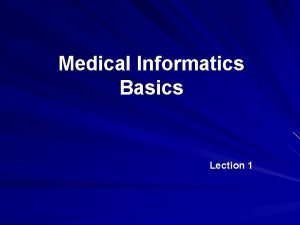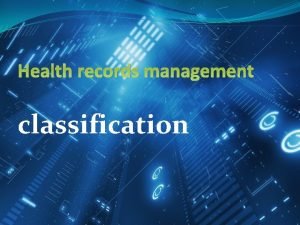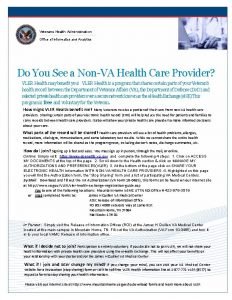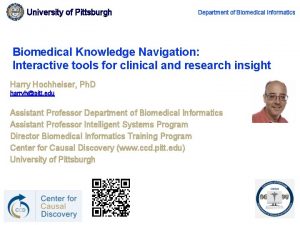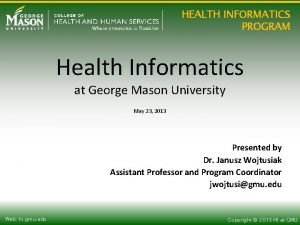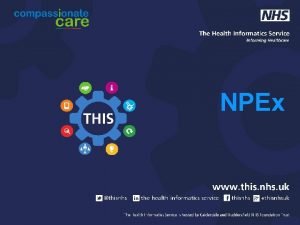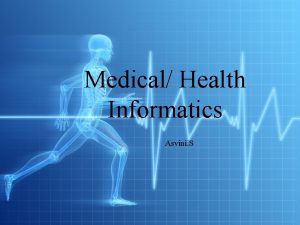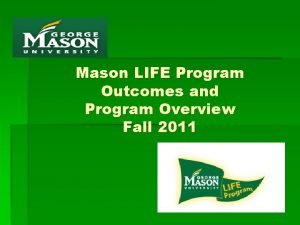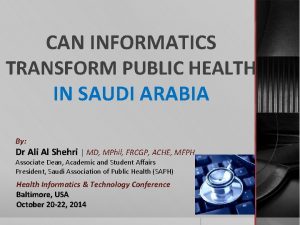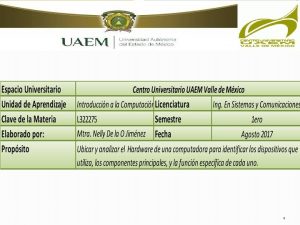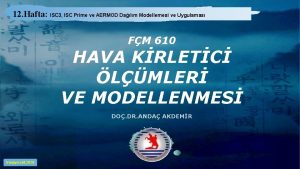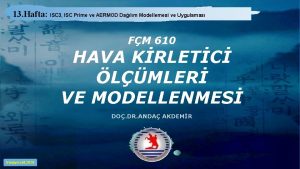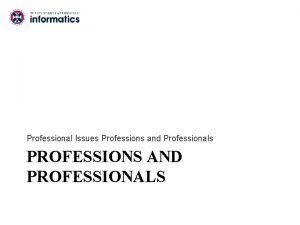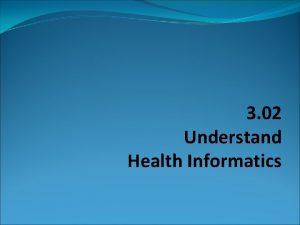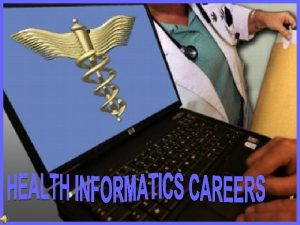Health Informatics and Information Management Professions 8312012 ISC

















- Slides: 17

Health Informatics and Information Management Professions 8/31/2012 ISC 471/HCI 571 Isabelle Bichindaritz 1

Agenda • Introduction to health informatics and information management professions. • The patient record history. • The evolution of the profession. • American Health Information Management Association (AHIMA) and American Medical Informatics Association (AMIA) • Foundations of research and education in health information management. • Professional code of ethics. • 8/31/2012 The future. ISC 471/HCI 571 Isabelle Bichindaritz 2

Health Information Management Profession • Main role of health information management (HIM): to support quality health care through quality information. • Fundamental change in the profession due to the infusion of information technology: – Electronic health record replaces paper-based patient record – Need to balance the patients’ rights to privacy and confidentiality of their health information with the legitimate use of this information for administrative, financial, clinical, research, and public health purposes. 8/31/2012 ISC 471/HCI 571 Isabelle Bichindaritz 3

The Patient Record • Electronic medical record – kept by each care provider or hospital about a patient they treat. • Legal documentation of that care or treatment. • Medical record can be used for several purposes: – Documentation for communication purposes, for legal proceedings, and for billing purposes. – Assessing the efficiency and effectiveness of health services. – Supporting strategic planning, administrative decision making, public health surveillance, research activities, and public policy development. 8/31/2012 ISC 471/HCI 571 Isabelle Bichindaritz 4

The Patient Record • Increased use of information about patients: – Growing complexity of health care (multiple providers working collaboratively) – Health care billing and reimbursement (for payers such as insurance companies and the Federal Government) – Control of quality care and treatment versus cost effectiveness and efficiency – Legal proceedings – Research, program evaluation (performance records), education, public health studies. 8/31/2012 ISC 471/HCI 571 Isabelle Bichindaritz 5

Evolution of the Patient Record • Early history • At first hand-written and paper-based (from hospital ledgers to individual patient records) • Became organized records. • Typed paper-based from 1874 on (detailed records of medical history, physical examination, labs, operative procedures, …). • Limitations of the paper-based record: • In one place at one time. • Data cannot be manipulated (aggregated). • Does not meet the requirements of influential forces. 8/31/2012 ISC 471/HCI 571 Isabelle Bichindaritz 6

Evolution of the Patient Record • Influential forces • Accreditation American Medical Association (AMA) 1847, American Hospital Association (AHA) 1848, American College of Surgeons (ACS) 1913 wanted to assess the quality of physician education and the resulting treatment of patients. They established standards and needed data to evaluate whether the standards were met. They joined to form the Joint Commission on the Accreditation of Hospitals (JCAH), which provides accreditation standards for 11 health care organizations and requirements for the patient records. • Licensing of health care facilities – State licensing requirements also involve patient records. 8/31/2012 ISC 471/HCI 571 Isabelle Bichindaritz 7

Evolution of the Patient Record • Influential forces • Paying for health care • Private insurance companies • Federal government (MEDICAID and MEDICARE) in 1965 • Both require data and fast access to medical records – “if it isn’t documented, it did not happen” • Managed care organizations Prospective payment system for seven health care services 8/31/2012 ISC 471/HCI 571 Isabelle Bichindaritz 8

Evolution of the Patient Record • Influential forces • 8/31/2012 Technology • 1989 -1991 – Institute of Medicine encourages the adoption of computer-based patient records (CPR): “will reside in a system specifically designed to support users by providing accessibility to complete and accurate data, alerts, reminders, clinical support systems, links to medical knowledge and other aids” and support aggregate data needs • 1990 s on - e-Health – health services and information delivered online • 2004 – President’s Information Technology Advisory Committee (PITAC) proposed • EHR’s for all Americans • Computer-assisted clinical decision-support • Computerized provider order entry • Secure, private, interoperable, electronic health information exchange • Office of the National Coordinator for Health Information Technology (ONC) supports this national health information infrastructure. ISC 471/HCI 571 Isabelle Bichindaritz 9

Evolution of the Profession • 1991 – American Health Information Management Association “AHIMA … leading the advancement and ethical use of quality health information to promote health and wellness worldwide. ” • 1989 - American Medical Informatics Association “AMIA aims to lead the way in transforming health care through trusted science, education, and the practice of informatics. ” 8/31/2012 ISC 471/HCI 571 Isabelle Bichindaritz 10

Evolution of the Profession • 1991 – American Health Information Management Association “Health information is the body of knowledge and practice that ensures the availability of health information to facilitate real-time health care delivery and critical health-related decision making for multiple purposes across diverse organizations, settings, and disciplines. ” • 1989 - American Medical Informatics Association “Biomedical informatics (BMI) is the interdisciplinary, scientific field that studies and pursues the effective uses of biomedical data, information, and knowledge for scientific inquiry, problem solving and decision making, motivated by efforts to improve human health. ” (www. amia. org) 8/31/2012 ISC 471/HCI 571 Isabelle Bichindaritz 11

AHIMA Association • American Health Information Management Association – – – – Roles and competencies for HIM professionals Workforce development Industry partnerships and collaborations Professional self-development Education reform Research Grantsmanship … 8/31/2012 ISC 471/HCI 571 Isabelle Bichindaritz 12

AHIMA Association • Training – Associate, baccalaureate degrees in HIM – Master’s degree in HIM or Biomedical informatics – Certificates in HIM or Biomedical informatics (generally graduate-level) – Doctorate level studies • Accreditation – CAHIIM (Commission on Accreditation for Health Informatics and Information Management Education) accredits associate and baccalaureate HIM degrees and approves Master’s degrees – AHIMA accredits Coding and Transcription certificates 8/31/2012 ISC 471/HCI 571 Isabelle Bichindaritz 13

AHIMA Association • Professional Certification – A number of eight credentials are certified by AHIMA Certified in Healthcare Privacy Certified in Healthcare Security Certified in Healthcare Privacy and Security Certified Coding Associate, Specialist, or Specialist-Physician based Registered Health Information Administrator Registered Health Information Technician • Certified professionals are obligated to continuing education units in two-year cycles 8/31/2012 ISC 471/HCI 571 Isabelle Bichindaritz 14

Professional Code of Ethics • A health information management professional shall (2004): 1. 2. 3. 4. 5. Advocate, uphold, and defend the individual's right to privacy and the doctrine of confidentiality in the use and disclosure of information. Put service and the health and welfare of persons before self-interest and conduct oneself in the practice of the profession so as to bring honor to oneself, their peers, and to the health information management profession. Preserve, protect, and secure personal health information in any form or medium and hold in the highest regards health information and other information of a confidential nature obtained in an official capacity, taking into account the applicable statutes and regulations. Refuse to participate in or conceal unethical practices or procedures and report such practices. Advance health information management knowledge and practice through continuing education, research, publications, and presentations. 8/31/2012 ISC 471/HCI 571 Isabelle Bichindaritz 15

Professional Code of Ethics 6. Recruit and mentor students, peers and colleagues to develop and strengthen professional workforce. 7. Represent the profession to the public in a positive manner. 8. Perform honorably health information management association responsibilities, either appointed or elected, and preserve the confidentiality of any privileged information made known in any official capacity. 9. State truthfully and accurately one’s credentials, professional education, and experiences. 10. Facilitate interdisciplinary collaboration in situations supporting health information practice. 11. Respect the inherent dignity and worth of every person. 8/31/2012 ISC 471/HCI 571 Isabelle Bichindaritz 16

The Future • Advancement of standards for data interchange and system interoperability, privacy, and security • Human-computer interfaces (virtual reality, serious gaming) for patient education and treatment • Translational medicine • Large-scale decision-support systems with interoperable knowledge bases • Preventative care and prognosis • Facilitate the education of the population to overcome socio-economic barriers to health • Contribute to making health information and healthcare affordable. 8/31/2012 ISC 471/HCI 571 Isabelle Bichindaritz 17
 Allied health professionals list
Allied health professionals list Observational health data sciences and informatics
Observational health data sciences and informatics Informatics basics
Informatics basics Health informatics
Health informatics Personal traits for health informatics services workers
Personal traits for health informatics services workers Va office of health informatics
Va office of health informatics Pitt health informatics
Pitt health informatics Health informatics gmu
Health informatics gmu Health informatics courses uk
Health informatics courses uk Health informatics career framework
Health informatics career framework The health informatics service
The health informatics service Health informatics ryerson
Health informatics ryerson Masonlife
Masonlife Health informatics in saudi arabia
Health informatics in saudi arabia Python for informatics
Python for informatics Python for informatics: exploring information
Python for informatics: exploring information Python for informatics
Python for informatics Python for informatics
Python for informatics

